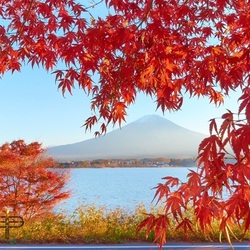To admire the falling snow, the Japanese came up with a whole ritual - Yukimi-zake.
Yukimi-zake is a tradition of drinking a cup of sake while watching the snow, it is the main pleasure of the winter season, like admiring cherry blossoms in spring or red momiji leaves in autumn. In the evenings, when it snows and large fluffy flakes gently fall outside the window, you can open a bottle of sake, fill a cup and sip rice wine alone, admiring the falling snowflakes and thinking about the frailty of life.
The Japanese most often depict a snowflake as a six-rayed structure. in Japan, they have always been depicted in accordance with natural laws, that is, with 3, 6 and 12 rays. The first to draw snowflakes was Doi Toshitsura, who acquired a microscope from the Dutch and began to study them, and in 1833 published the first natural science study of snow in Japan, Sekka zusetsu (Atlas of Snowflakes). Since then, Doi Toshitsura was nicknamed the Prince of Snow in history. In 1840, Shoku Sekka zusetsu was released - a continuation of the Atlas of Snowflakes. In the first part 98 snowflakes are sketched, and in the second - 97 snowflakes. The atlas did not go on sale, it was printed at home in small quantities. But soon Suzuki Bokushi redrawn Doi Toshitsura's snowflakes and put them in his book "Tales of Snow Hokuetsu". It was thanks to this book that Doi's sketches spread widely among all Japanese. Since then, the motif of snowflakes has been widely included in the life of the Japanese, for example, utensils for the tea ceremony or kimono patterns often had snowflake patterns. The motives of snowflakes immediately spread among the Japanese, prints often depicted beauties in kimonos, completely covered with images of snowflakes, or they adorned obi belts.
On the basis of Doi's atlas, numerous Kamon family coats of arms were created. Therefore, each snowflake got its own name, for example, there is Yukiva - a snow outline, Yamabuki-yuki - a snowflake in the shape of a flower, Harukaze-yuki - spring snow, Komori-yuki - a snowflake in the form of bats, Kokumoti-yuki - a black snowflake on a white background , Sanya-yuki is the snow of a mountain valley, Hanagata-yuki is a flower-shaped snowflake, Yama-yuki is a snowflake with teeth, Ya-yuki is a snowflake of arrows, Tsurara-yuki is an ice crystal, and so on. The Japanese have even an order of magnitude more names for snowflakes than the Eskimos!
***
I cannot find the blossoming plum blossom
What I wanted to show a friend:
It snowed here -
And I cannot find out
Where are the plums here, where is the white snow?
Yamabe no Akahito
***
It feels like
They fly from heaven to earth
Moon sequins
Snow falls in the night
To the traveler on the sleeves.
Kagawa Kageki
Share the jigsaw puzzle
| Pieces | 720 |
| Size | 2160x1200 |
| Complexity | expert |
| Added | Tatia |
| Published | 10/26/14 |
| Players | 15 |
| Best time | 00:00:17 |
| Average time | 02:01:25 |



















Jigsaw puzzle comments
Add a comment